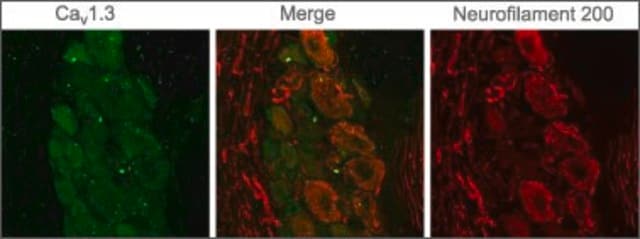A274
Monoclonal Anti-H+/K+ ATPase (β Subunit) antibody produced in mouse
clone 2G11, ascites fluid, buffered aqueous solution
Seleccione un Tamaño
MXP 15,279.00
Fecha estimada de envío28 de mayo de 2025
Seleccione un Tamaño
About This Item
MXP 15,279.00
Fecha estimada de envío28 de mayo de 2025
Productos recomendados
origen biológico
mouse
Nivel de calidad
conjugado
unconjugated
forma del anticuerpo
ascites fluid
tipo de anticuerpo
primary antibodies
clon
2G11, monoclonal
Formulario
buffered aqueous solution
mol peso
antigen 60-80 kDa (glycosylated form)
reactividad de especies
pig, mouse, rabbit, rat, bovine, ferret, canine
técnicas
immunohistochemistry (frozen sections): suitable
indirect immunofluorescence: 1:2,000
western blot (chemiluminescent): 1:4,000
isotipo
IgG1
Nº de acceso UniProt
Condiciones de envío
dry ice
temp. de almacenamiento
−20°C
modificación del objetivo postraduccional
unmodified
Información sobre el gen
mouse ... Atp4b(11945)
rat ... Atp4b(24217)
Descripción general
Inmunógeno
Aplicación
Western Blotting (1 paper)
Forma física
Cláusula de descargo de responsabilidad
¿No encuentra el producto adecuado?
Pruebe nuestro Herramienta de selección de productos.
Código de clase de almacenamiento
10 - Combustible liquids
Clase de riesgo para el agua (WGK)
WGK 1
Punto de inflamabilidad (°F)
Not applicable
Punto de inflamabilidad (°C)
Not applicable
Equipo de protección personal
Eyeshields, Gloves, multi-purpose combination respirator cartridge (US)
Elija entre una de las versiones más recientes:
¿Ya tiene este producto?
Encuentre la documentación para los productos que ha comprado recientemente en la Biblioteca de documentos.
Active Filters
Nuestro equipo de científicos tiene experiencia en todas las áreas de investigación: Ciencias de la vida, Ciencia de los materiales, Síntesis química, Cromatografía, Analítica y muchas otras.
Póngase en contacto con el Servicio técnico







